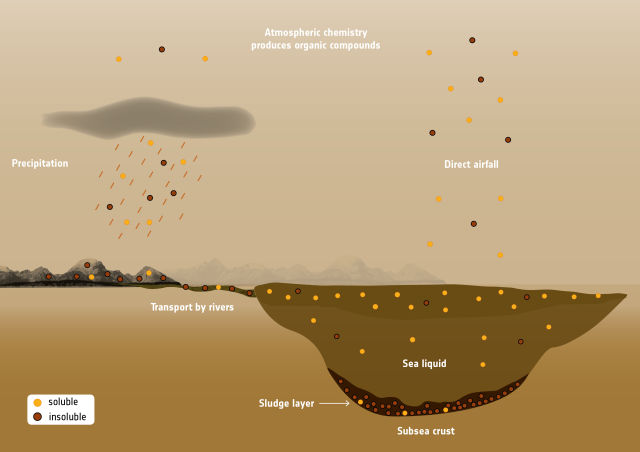Science
Related: About this forumTitanís great lakes appear to be filled with clear, colorless methane

Liquid seas exist on the surface of just two worlds in the Solar System: Earth and Saturn's moon Titan. Discovered by NASA's Cassini spacecraft about a decade ago, the hydrocarbon seas of Titan are more exotic, of course, as they exist in liquid form at temperatures around -180 degrees Celsius.
Now, after the Cassini spacecraft has made a number of flybys of Titan, scientists assessing light and other radiation emanating from the moon's surface say they have a better handle on exactly what is in one of those seas. And to their surprise, they have found that the second largest lake on Titan, Ligeia Mare, is composed of nearly pure methane.
“We expected to find that Ligeia Mare would be mostly ethane, which is produced in abundance in the atmosphere when sunlight breaks methane molecules apart,” said Alice Le Gall, lead author of the new study. “Instead, this sea is predominantly made of pure methane."
Further analysis of the data, which assessed the transparency of the sea, indicated that this methane extends to a depth of about 160 meters in some locations, down to a sludge layer atop the moon's crust. This combination of sea and seafloor suggests that in Titan's atmosphere, nitrogen and methane react to form organic molecules, which then fall to the surface as a methane rain. The heaviest of these molecules, such as benzene, sink to the bottom of the sea.
Were you to boat upon Titan, then, you might gaze down into a clear, deep sea. Instead of being colored blue like Earth's oceans, however, these clear seas would bear the yellowish and orangish hues of Titan's skies. And might anything live in those oceans? It's a tantalizing possibility to consider.
http://arstechnica.com/science/2016/04/titans-great-lakes-appear-to-be-filled-with-clear-colorless-methane/
immoderate
(20,885 posts)It's the right conditions.
--imm
phazed0
(745 posts)I always hear the "building blocks of life" argument but rarely hear about the temperatures in the same breath. If hot is the presence of energy, cold is the absence of. -180c cold is damn cold, only 90c away from the 'temperature' of space itself. Without some (more) energy to get molecules bouncing around energetically, to provide "chance" and reaction in the molecular world, I would imagine any life that could come about would be slowed considerably in comparison to Earth's journey.
If we assume the solar system and it's bodies are relatively the same age (4.7 Billion), well, it took Earth around 600 million years to start life and that was with "hot temps" of around 100c. Abiogenesis, the act of organic living materials produced naturally from inorganic materials, seems to support the need for heat energy.
I fear there will be no life there and we will need to reach much further to find it... but I will be pleasantly surprised if life were to be found!
![]()
immoderate
(20,885 posts)You are talking about less heat than we are accustomed to, but given a liquid environment, chemical activity, available energy, there is evidence that matter will self organize where possible. I think the criterion here is to facilitate entropy.
Here's some info:
https://www.quantamagazine.org/20140122-a-new-physics-theory-of-life/
--imm
phazed0
(745 posts)MillennialDem
(2,367 posts)outside chances of life imho, Europa and Enceladus are prime candidates.
AuntPatsy
(9,904 posts)mindwalker_i
(4,407 posts)elljay
(1,178 posts)SoapBox
(18,791 posts)fishing in those lakes.
![]()
fred v
(271 posts)They'd be there before Christmas!
sulphurdunn
(6,891 posts)that are able to live in methane by producing their own oxygen.
Thor_MN
(11,843 posts)“We expected to find that Ligeia Mare would be mostly ethane, which is produced in abundance in the atmosphere when sunlight breaks methane molecules apart”
Methane is CH4. Ethane is C2H6. To produce ethane from methane, you have to knock a hydrogen off a methane and have it combine with another methane with a hydrogen removed. So it's a bit more complicated than sunlight breaking down methane.